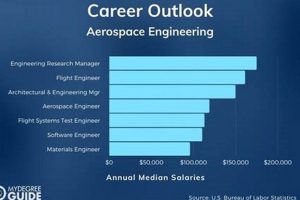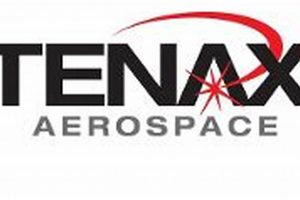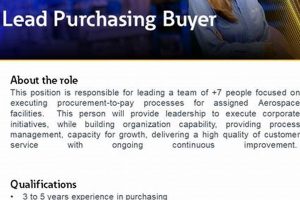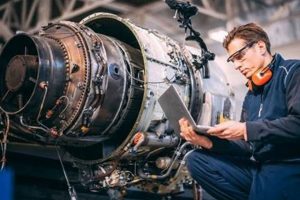Positions within the aerospace sector encompass a wide range of roles related to the design, development, manufacturing, and operation of aircraft and spacecraft. This includes engineering positions such as aerospace engineers who design aircraft, software engineers who develop flight control systems, and manufacturing engineers who oversee the production process. Beyond engineering, the field encompasses roles in research and development, testing, quality control, and management.
These careers contribute significantly to technological advancement, national security, and economic growth. The aerospace industry has historically been a driver of innovation, pushing the boundaries of materials science, propulsion systems, and computer technology. Furthermore, personnel in this sector often find themselves involved in cutting-edge projects with tangible impacts on society, ranging from improving air travel safety to exploring space.
The subsequent sections will delve into specific roles, required qualifications, skills development, and factors influencing the job market within this dynamic field. We will also examine emerging trends and potential future career paths.
Tips for Securing a Position in the Aerospace Sector
The following recommendations provide guidance for individuals seeking professional opportunities in the aerospace industry. These tips emphasize strategic planning, skill development, and effective networking.
Tip 1: Develop a Strong Technical Foundation: Possessing a solid understanding of engineering principles, physics, and mathematics is fundamental. A degree in aerospace engineering, mechanical engineering, or a related field is highly advantageous.
Tip 2: Gain Relevant Experience Through Internships: Internships offer invaluable practical experience and exposure to industry practices. Seek opportunities with aerospace companies, research institutions, or government agencies.
Tip 3: Cultivate Specialized Skills: Identify niche areas within the aerospace sector, such as propulsion systems, avionics, or composite materials. Develop expertise in these areas through specialized coursework, certifications, or personal projects.
Tip 4: Master Industry-Standard Software: Proficiency in software packages commonly used in aerospace, such as CAD (Computer-Aided Design) software, CFD (Computational Fluid Dynamics) software, and FEA (Finite Element Analysis) software, is essential.
Tip 5: Build a Professional Network: Attend industry conferences, career fairs, and networking events. Connect with aerospace professionals through online platforms like LinkedIn.
Tip 6: Tailor Resumes and Cover Letters: Customize application materials to highlight skills and experience relevant to specific positions. Emphasize accomplishments and quantify contributions whenever possible.
Tip 7: Prepare for Technical Interviews: Technical interviews often involve problem-solving exercises and questions designed to assess knowledge of aerospace principles. Practice answering common interview questions and review relevant technical concepts.
Tip 8: Obtain Relevant Certifications: Consider pursuing certifications relevant to specific aerospace roles, such as certifications in project management, quality control, or safety engineering.
Adherence to these suggestions can significantly increase the likelihood of securing a desirable placement within the competitive landscape. A proactive and strategic approach is paramount to achieving success in this sector.
The subsequent sections will further explore career progression and expected compensation within the aerospace industry.
1. Engineering Expertise
Engineering expertise constitutes a cornerstone of the aerospace sector. The demand for skilled engineers underpins the design, development, and testing of aircraft, spacecraft, and related systems. Without robust engineering capabilities, the realization of advancements in areas such as aerodynamics, propulsion, and materials science remains unattainable. A direct causal relationship exists: enhanced engineering proficiency precipitates advancements in aerospace technology, leading to the creation of novel designs and improved operational efficiencies. For example, the development of high-bypass turbofan engines, a critical innovation in aviation, depended heavily on advancements in fluid dynamics, materials science, and control systems engineering. The expertise of engineers in these disciplines was fundamental to the successful implementation of this technology.
The reliance on engineering knowledge extends beyond design to encompass manufacturing, maintenance, and quality control. Aerospace manufacturing necessitates the application of precision engineering techniques to ensure components meet stringent tolerances and safety standards. Maintenance operations require engineers to diagnose and resolve complex technical issues, preventing system failures and ensuring operational safety. Quality control engineers employ statistical analysis and testing methodologies to verify that products conform to design specifications. The practical significance of this is evident in the rigorous testing procedures applied to aircraft components, which are designed to simulate extreme operating conditions and identify potential weaknesses. The Challenger disaster, for example, underscored the dire consequences of lapses in engineering oversight and quality control procedures.
In summary, engineering expertise is not merely a component of aerospace careers; it is the indispensable foundation upon which the entire industry rests. The ongoing demand for qualified engineers highlights the sector’s continuous need for innovation and problem-solving capabilities. Addressing the challenges of developing sustainable aviation technologies, exploring deep space, and enhancing national security requires a sustained commitment to fostering engineering talent and promoting advancements in engineering knowledge.
2. Regulatory Compliance
Regulatory compliance forms an integral framework within the aerospace sector, directly influencing the nature and execution of related roles. Adherence to stringent regulations is non-negotiable, given the safety-critical nature of aerospace operations and the potential for catastrophic consequences arising from non-compliance. These regulations originate from national and international bodies and dictate virtually every aspect of aerospace activity.
- Airworthiness Standards
Aircraft design, manufacturing, and maintenance are governed by comprehensive airworthiness standards established by regulatory agencies such as the Federal Aviation Administration (FAA) in the United States and the European Aviation Safety Agency (EASA) in Europe. Aerospace engineers, technicians, and quality control personnel are tasked with ensuring strict adherence to these standards. Failure to comply can lead to grounding of aircraft, fines, and potential legal liabilities. An example is the extensive certification process required for new aircraft models, involving rigorous testing and documentation to demonstrate compliance with airworthiness requirements.
- Safety Management Systems (SMS)
Aerospace organizations are mandated to implement Safety Management Systems (SMS) to proactively identify and mitigate potential hazards. This necessitates the involvement of safety managers, risk analysts, and operational staff in continuously monitoring and improving safety protocols. Incident reporting, hazard analysis, and safety audits are key components of SMS. An example would be an airline’s SMS program that requires pilots and maintenance crews to report all potential safety concerns, which are then investigated and addressed by a safety review board.
- Export Control Regulations
Due to the strategic significance of aerospace technology, stringent export control regulations govern the international transfer of aerospace products and technologies. Compliance with these regulations requires export control specialists to meticulously track and manage the movement of sensitive items, ensuring adherence to national security policies and international treaties. Incorrectly classifying and shipping an item without proper authorization can lead to significant fines and penalties, and even result in criminal charges.
- Environmental Regulations
The aerospace sector faces increasing pressure to reduce its environmental impact, leading to stringent environmental regulations governing emissions, noise pollution, and waste management. Environmental engineers and sustainability managers within the industry are tasked with developing and implementing strategies to minimize the environmental footprint of aerospace operations. This includes initiatives such as developing more fuel-efficient aircraft, utilizing sustainable aviation fuels, and implementing noise abatement procedures at airports.
The preceding aspects of regulatory compliance underscore its profound influence on every facet of the aerospace industry. Professionals employed in these capacities must possess a thorough understanding of applicable regulations, meticulous attention to detail, and a commitment to upholding the highest standards of safety and security. The interconnectedness of regulatory compliance and “the aerospace jobs” ensures the safe, secure, and sustainable operation of the global aerospace system.
3. Innovation and Research
Innovation and research serve as vital catalysts within the aerospace sector, inextricably linked to the evolution and diversification of career paths. The relentless pursuit of advancements in areas such as aerodynamics, propulsion systems, materials science, and avionics directly fuels the creation of specialized roles requiring advanced knowledge and technical proficiency. These roles are instrumental in pushing the boundaries of aerospace technology and enhancing overall system performance. A clear example is the ongoing development of electric propulsion systems for aircraft, which necessitates the expertise of engineers and scientists specializing in battery technology, electric motor design, and power electronics.
The significance of innovation and research extends beyond the creation of new technologies to encompass the improvement of existing systems and processes. Continuous efforts to enhance fuel efficiency, reduce emissions, and improve safety are driven by research activities that require specialized skill sets in areas such as computational fluid dynamics, structural analysis, and risk assessment. These activities directly impact the operational efficiency and environmental sustainability of the aerospace industry. For example, advancements in computational fluid dynamics have enabled engineers to optimize aircraft wing designs, leading to significant reductions in drag and fuel consumption.
In summary, the aerospace industry’s reliance on innovation and research has a profound effect on the structure and composition of roles within the sector. The need for specialized expertise in emerging technologies and advanced analytical techniques drives the demand for highly skilled professionals capable of contributing to the ongoing evolution of the industry. Continued investment in innovation and research is essential for maintaining a competitive edge and addressing the challenges of future aerospace endeavors.
4. Global Collaboration
Global collaboration forms a critical component of the modern aerospace sector, fundamentally shaping the landscape of related careers. The development and production of aircraft and spacecraft increasingly rely on international partnerships and supply chains, necessitating personnel equipped to navigate cross-cultural communication, international regulations, and complex logistical arrangements. Without effective global collaboration, ambitious projects, such as the International Space Station or the development of next-generation aircraft, would be logistically and financially infeasible. This collaborative environment directly influences the skills and expertise required for roles within the industry, demanding proficiency in areas such as international business law, supply chain management, and cross-cultural communication.
Aerospace engineers, for instance, routinely collaborate with counterparts from different countries, sharing technical expertise and contributing to joint design efforts. This often involves adapting designs to meet diverse regulatory requirements and integrating components manufactured in various locations. Project managers oversee international teams, coordinating tasks and ensuring that projects remain on schedule and within budget. Furthermore, the establishment of global supply chains requires logistics specialists and procurement officers capable of sourcing materials and components from international suppliers while adhering to stringent quality control standards. These positions necessitate a deep understanding of international trade regulations and the ability to manage complex logistics networks. A prime example is the Airbus A350, a commercial airliner whose components are sourced from multiple countries, requiring meticulous coordination and collaboration across international borders throughout the manufacturing process.
In summary, the aerospace industry’s reliance on global collaboration has led to the emergence of a diverse array of careers that require specialized skills and expertise. The ability to navigate international partnerships, manage global supply chains, and effectively communicate across cultural boundaries is becoming increasingly essential for professionals seeking positions in this dynamic sector. Challenges related to geopolitical instability and trade disputes can disrupt global supply chains, emphasizing the importance of adaptable and resilient collaboration strategies. Understanding the intricacies of global collaboration is paramount for individuals pursuing careers within the modern aerospace industry.
5. Mission Critical
The designation “mission critical” carries substantial weight within the aerospace domain, exerting considerable influence on the expectations and responsibilities associated with “the aerospace jobs.” A mission-critical task is defined as an activity or system whose failure would have severe consequences, potentially resulting in loss of life, damage to property, or significant operational disruption. The inherent risks associated with flight and space travel necessitate a heightened emphasis on reliability, precision, and adherence to rigorous safety protocols. Consequently, personnel entrusted with mission-critical responsibilities must demonstrate exceptional competence, unwavering attention to detail, and a steadfast commitment to minimizing potential hazards. This responsibility permeates roles from design engineers to maintenance technicians. For example, a software engineer developing flight control systems cannot afford errors in code, as even minor glitches could compromise the aircraft’s stability and jeopardize the safety of passengers and crew. Similarly, a quality control inspector must meticulously verify the integrity of critical components, ensuring that they meet stringent performance standards.
The aerospace industry’s approach to mission-critical activities emphasizes redundancy, rigorous testing, and continuous improvement. Redundant systems are implemented to provide backup capabilities in the event of a failure, minimizing the likelihood of catastrophic outcomes. Extensive testing, including simulations and flight tests, is conducted to identify and address potential vulnerabilities before systems are deployed in operational environments. Furthermore, the aerospace sector embraces a culture of continuous improvement, constantly seeking to enhance safety protocols, refine maintenance procedures, and mitigate risks. The practical significance of this is seen in commercial aviation, where advancements in technology and operational procedures have steadily reduced accident rates over the decades. This progress is directly attributable to the industry’s unwavering focus on ensuring the reliability and safety of flight operations.
The intersection of mission-critical demands and career paths in aerospace necessitates a highly skilled and dedicated workforce. Individuals pursuing the aerospace jobs must not only possess the technical expertise required for their respective roles but also internalize the critical importance of their contributions to ensuring safe and reliable operations. While advancements in automation and artificial intelligence may augment certain tasks, the ultimate responsibility for maintaining mission-critical systems rests with human professionals. The aerospace sector’s commitment to safety, security, and reliability remains paramount, shaping the responsibilities of its workforce and driving innovation across the industry.
6. Precision Manufacturing
Precision manufacturing is a cornerstone of the aerospace industry, directly influencing the roles and responsibilities associated with positions within this sector. Given the safety-critical nature of aerospace components and systems, adherence to exacting tolerances and stringent quality control measures is paramount. Precision manufacturing techniques underpin the creation of reliable, high-performance aircraft and spacecraft.
- Material Selection and Processing
The aerospace industry relies on advanced materials such as titanium alloys, composites, and nickel-based superalloys due to their strength-to-weight ratios and resistance to extreme temperatures and stresses. Precision manufacturing techniques are required to process these materials into complex shapes while maintaining their structural integrity. For instance, the production of turbine blades for jet engines necessitates intricate casting and machining processes to achieve the precise airfoil geometry and surface finish required for optimal performance.
- Dimensional Accuracy and Tolerances
Aerospace components must conform to extremely tight dimensional tolerances to ensure proper fit and functionality. The use of advanced machining techniques, such as CNC (Computer Numerical Control) machining, and precise measurement tools, such as coordinate measuring machines (CMMs), is essential for achieving these tolerances. The precise fit of components such as landing gear struts and wing spars directly affects the aircraft’s structural integrity and flight characteristics.
- Surface Finish and Coatings
Surface finish plays a critical role in the performance and durability of aerospace components. Precise surface finishing techniques, such as grinding, polishing, and honing, are employed to minimize friction, reduce wear, and improve corrosion resistance. Furthermore, specialized coatings, such as thermal barrier coatings and anti-corrosion coatings, are applied to protect components from extreme environments. The surface finish of turbine blades, for example, directly affects their aerodynamic efficiency and resistance to thermal stress.
- Quality Assurance and Inspection
Rigorous quality assurance and inspection processes are integral to precision manufacturing in the aerospace industry. Non-destructive testing (NDT) methods, such as ultrasonic testing, radiographic testing, and eddy current testing, are used to detect internal flaws and ensure the structural integrity of components without causing damage. In addition, statistical process control (SPC) techniques are employed to monitor manufacturing processes and identify potential deviations from specifications. These methods help to ensure each part meets the high aerospace standards.
In conclusion, precision manufacturing is not merely a process but a fundamental requirement for the aerospace jobs. The ability to produce components with exceptional accuracy, reliability, and performance is essential for ensuring the safety, efficiency, and longevity of aircraft and spacecraft. A career in precision manufacturing is essential for the aerospace industry.
7. Continuous Learning
Within the dynamic landscape of the aerospace sector, continuous learning is not merely an option but an imperative for sustained professional relevance. Technological advancements, evolving regulatory frameworks, and the demand for increased efficiency and safety necessitate a commitment to ongoing skill development for individuals employed in “the aerospace jobs.”
- Adaptation to Emerging Technologies
The rapid pace of technological innovation in aerospace demands continuous acquisition of new skills. From additive manufacturing techniques to advanced avionics systems, aerospace professionals must remain abreast of emerging technologies to effectively contribute to design, manufacturing, and maintenance processes. A failure to adapt to these changes can render existing skill sets obsolete, limiting career advancement opportunities and potentially compromising operational effectiveness. For instance, professionals working with composite materials must continually update their knowledge to incorporate advancements in material science and manufacturing processes.
- Compliance with Evolving Regulatory Standards
Aerospace is a heavily regulated industry, with standards and procedures subject to frequent revisions. Adherence to these evolving regulatory standards is essential for ensuring safety, security, and environmental compliance. Aerospace professionals, ranging from engineers to maintenance technicians, must engage in continuous learning to maintain their certifications and ensure their practices align with the latest regulatory requirements. An example is the mandatory training and recertification required for aircraft maintenance personnel to remain compliant with FAA or EASA regulations.
- Mastering Advanced Software and Simulation Tools
The design, analysis, and simulation of aerospace systems rely heavily on sophisticated software tools. Proficiency in these tools is critical for engineers, scientists, and technicians involved in “the aerospace jobs.” Continuous learning is required to master new software versions, explore advanced functionalities, and leverage these tools effectively to optimize designs and processes. This could include training courses, industry conferences, online resources, or professional certifications in specific software packages.
- Embracing Interdisciplinary Collaboration
The complexity of modern aerospace projects necessitates collaboration across diverse disciplines. Aerospace professionals must possess a broad understanding of related fields and the ability to effectively communicate and collaborate with specialists from different backgrounds. Continuous learning can facilitate the development of interdisciplinary knowledge and foster effective teamwork. For example, an aerospace engineer working on a propulsion system may need to understand aspects of electrical engineering, materials science, and thermodynamics to effectively collaborate with specialists in those areas.
The multifaceted nature of continuous learning underscores its integral role in sustaining the competitiveness and competence of the aerospace workforce. By actively pursuing opportunities for skill development and knowledge acquisition, professionals engaged in “the aerospace jobs” can enhance their individual contributions and contribute to the overall advancement of the sector.
Frequently Asked Questions Regarding “The Aerospace Jobs”
The following section addresses common inquiries and misconceptions surrounding careers within the aerospace industry. These responses aim to provide clear and concise information.
Question 1: What are the fundamental educational requirements for entry-level aerospace positions?
A bachelor’s degree in aerospace engineering, mechanical engineering, or a closely related field is generally considered the minimum educational requirement for entry-level engineering positions. Some specialized roles may require a master’s degree or doctorate.
Question 2: Is prior military service a significant advantage when applying for aerospace positions?
While not a strict requirement, prior military service can be advantageous, particularly for positions involving government contracts or national security. Military experience often provides valuable technical skills, leadership experience, and a strong understanding of operational procedures.
Question 3: What are the key skills and competencies that aerospace employers seek in prospective employees?
Employers typically seek candidates with strong analytical skills, problem-solving abilities, technical proficiency, and the capacity for teamwork. Excellent communication skills and a commitment to continuous learning are also highly valued.
Question 4: Are there specific certifications that can enhance an individual’s prospects in the aerospace job market?
Certifications such as those offered by professional engineering societies (e.g., Professional Engineer (PE) license) or specialized certifications in areas like project management or quality control can enhance a candidate’s credentials and demonstrate a commitment to professional development.
Question 5: How does the current economic climate impact the availability of aerospace positions?
The aerospace industry is subject to cyclical fluctuations, influenced by factors such as government spending, commercial airline performance, and technological advancements. Economic downturns can lead to hiring freezes or layoffs, while periods of growth typically result in increased job opportunities.
Question 6: What are some of the emerging trends that are shaping the future of “the aerospace jobs?”
Emerging trends include the development of sustainable aviation technologies, the increasing use of automation and artificial intelligence, the growth of the space tourism industry, and the proliferation of unmanned aerial vehicles (UAVs). These trends are creating new career opportunities and requiring professionals to adapt to evolving skill requirements.
In summary, securing a position in the aerospace sector requires a combination of technical expertise, relevant experience, and a proactive approach to professional development. Understanding the industry’s dynamics and adapting to emerging trends are crucial for long-term career success.
The subsequent section will explore resources and strategies for career advancement within the aerospace industry.
Conclusion
This exploration of “the aerospace jobs” has highlighted the diverse range of opportunities within the sector, emphasizing the critical need for specialized skills, continuous learning, and adherence to stringent regulatory standards. The sector’s reliance on innovation, global collaboration, and mission-critical applications shapes the expectations and responsibilities associated with these roles. From engineering expertise to precision manufacturing, each facet of aerospace demands a highly skilled and dedicated workforce.
The future of aerospace hinges on the ability to adapt to emerging technologies, address environmental concerns, and maintain a commitment to safety and security. Aspiring professionals should prioritize the development of relevant skills, seek out opportunities for practical experience, and cultivate a mindset of lifelong learning to succeed in this demanding yet rewarding field. The pursuit of “the aerospace jobs” offers the opportunity to contribute to advancements that shape the future of transportation, exploration, and national security.







